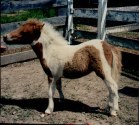Early foals, colostrum, diagnosing milk
The Seasonís First Babies
Believe it or not, but new foals are arriving. Early foals are a little more challenging. Some are just early while others have not prepared their mothers for this big event. The lack of milk or the delay of milk letdown are the big challenges of foaling at this time of the year.
There are a couple of simple observations that will assure us there is normal milk flow. Of course, we have already noticed that the udder is full. If the udder was not filling by two weeks before foaling date for the first time mare, or a week ahead for the experienced mother, you would have already called us. There are some excellent medications for stimulating milk letdown, but they have to actually be given to the mare in order to be effective. They are most effective if given before the foal is born, but will help if given for five days after foaling. Please keep this in mind for the mare that is not developing an udder. The reward for giving this oral medication a few days before foaling is not having to raise the foal yourself!
The foal will start nursing mom shortly after birth. If the mare is letting her milk down, you will see the foal having its first bowel movement within a couple of hours. The first two will be dark, hard, and pelleted. The next one will start to show the yellow color of milk and will be soft. In its own way this can be one of the prettiest sights we see. It tells you the foal is receiving plenty of milk and probably received adequate colostrum as well.
If the foal is nursing but is humping up with its tail raised, it could be alerting us to a problem. It could be merely constipated. If so an enema will help it pass the hard stool and allow movement of the softer milk stool. If the foal is not receiving enough milk it will most certainly be constipated. This is also a signal to start supplementing the baby. They may continue standing for 48 hours after birth, but without milk they will be down shortly thereafter with a very poor prognosis for recovery.
So a straining foal can indicate:
Even with prompt attention, if the foal has to be supplemented it probably has not received its colostrum. Even though the bowels will become active with supplemental feeding, the foalís immunity will be low and we must be very alert to the occurrence of navel or joint ill. This is seen three days after birth and must be treated as an emergency.
The other sign the foal gives us can be confusing. If the newborn foal is sleeping it is hopefully because its stomach is full. It may also be because it is weak! Once again, the best way to tell is to check the stool. If the stool is the butterscotch color we see when plenty of milk is in the stomach, the baby is sleeping because it is content.
Prompt action at foaling along with close observation will help the baby through the critical first three days without setbacks. The foal will tell us in its own way when it is happy and content.
CLICK BELOW TO DISPLAY A PRINTER-FRIENDLY COPY OF THIS ARTICLE
Select "Open this file from its current location," if you just want to print it out,
it will open in a simple word processing application, select the print button.
(unless you want to save this article in your computer's memory)

 TheSeasonsFirstBabies.rtf
TheSeasonsFirstBabies.rtf